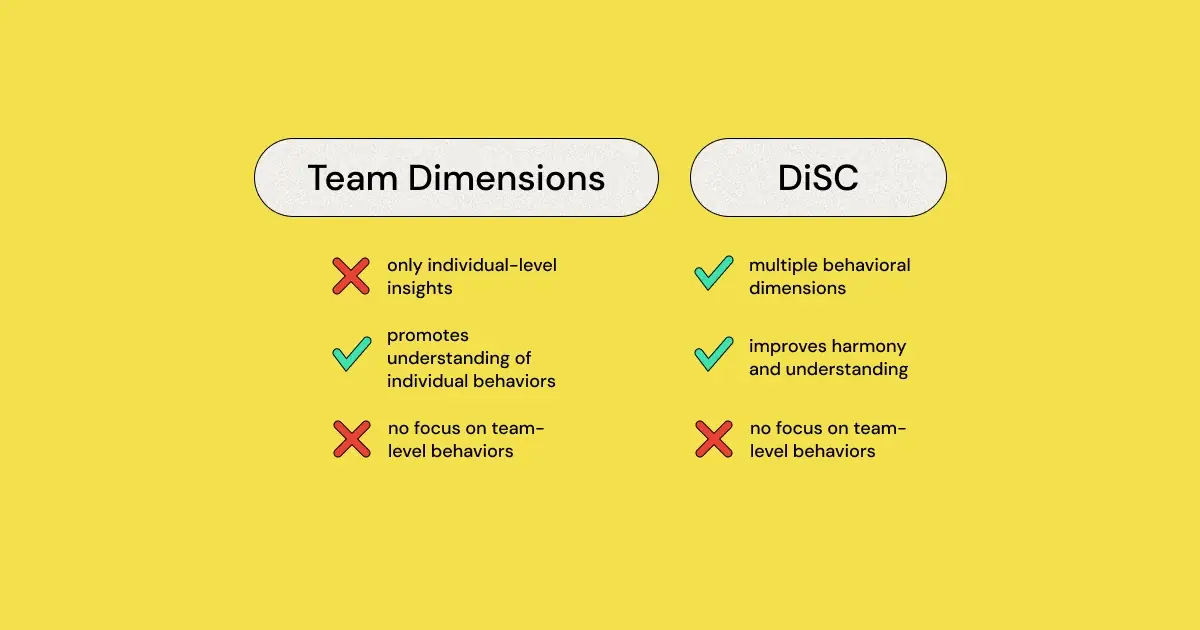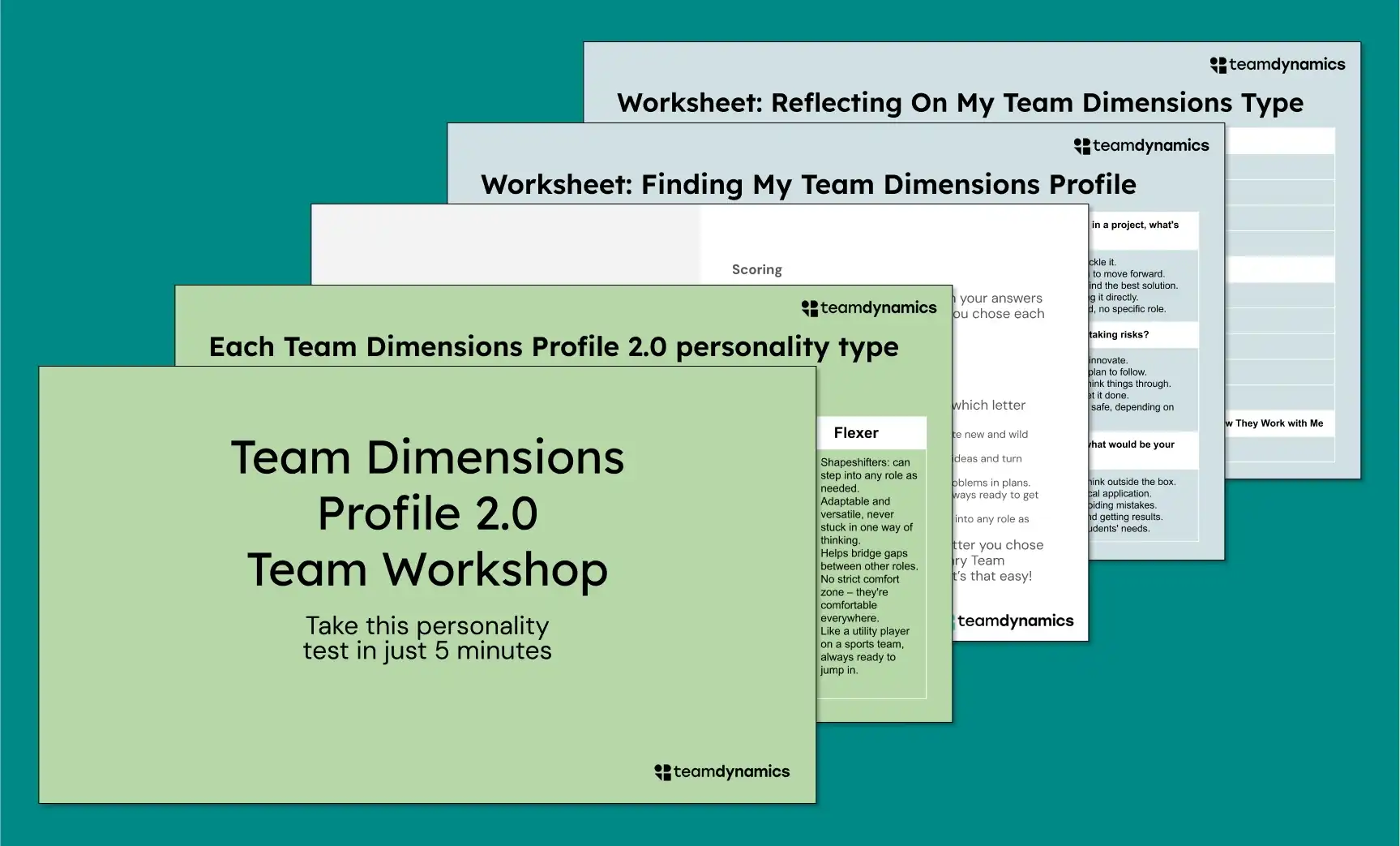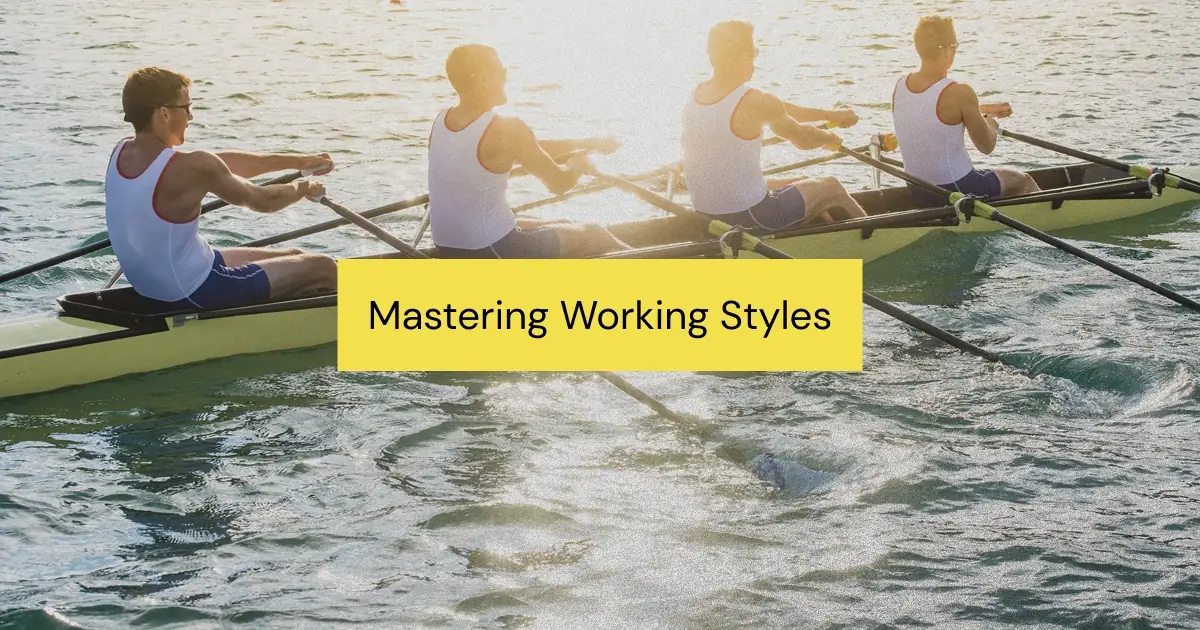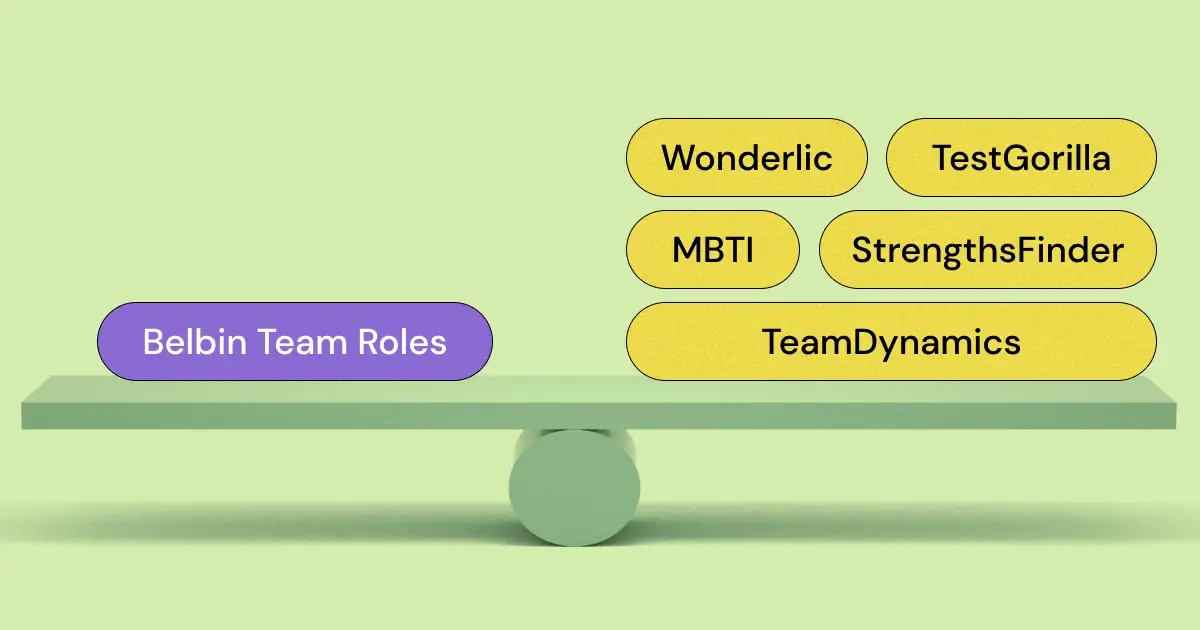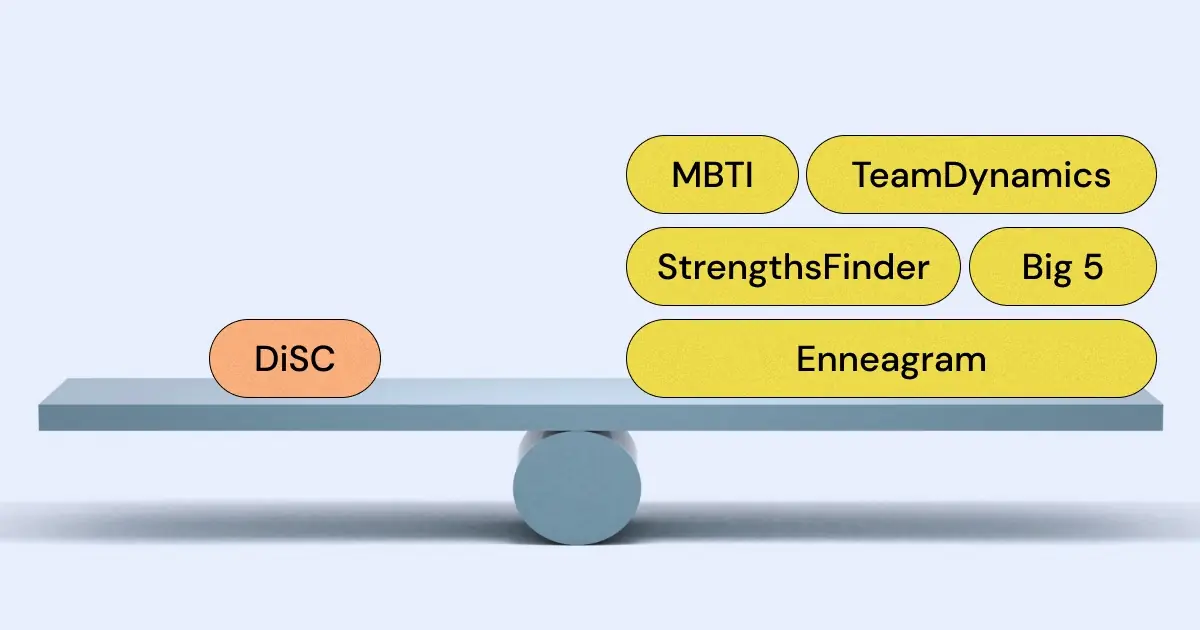When it comes to team building, understanding each team member's unique personality is as important as understanding their skills and roles. Two tools that have gained popularity in recent years are the Team Dimensions Profile and DiSC. Both of these tests are designed to delve into the different personality types found within a team, helping to enhance team dynamics, productivity, and overall harmony.
The Team Dimensions Profile is a personality test that identifies a person's natural team role, from being a creator or an executor, to a flexer who can adapt to different roles. It's a tool that helps team members understand their strengths, embrace their role, and work better together.
Looking for an alternative to Team Dimensions? Check out the 5 best alternatives to Team Dimensions Profile 2.0.
On the other side, we have DiSC. This test focuses on four personality traits: Dominance, Influence, Steadiness, and Conscientiousness. It assesses how these traits influence a person's behavior in a team context, providing insight into how individuals can best contribute to their teams.
So whether you're leaning towards the Team Dimensions Profile Test, considering DiSC, understanding these tools can be a game-changer for team dynamics. But how do these two tests compare, and which one might serve your team best? Let's dive deeper to find out.
Wondering what your Team Dimensions 2.0 Profile is? Check out our FREE downloadable resource!
Unpacking the Team Dimensions 2.0 Test
If you've ever been part of a sports team, you know that each player has a specific position. The same concept applies to teams in other areas of life too, and that's where the Team Dimensions Profile Assessment comes into play. This test helps to figure out your 'position' in a team setting, but instead of working out if you're a striker or a goalie, it's about understanding your role within a team's dynamics.
The Team Dimensions 2.0 Test is designed to reveal the strengths and roles of individuals in a team. It is rooted in the understanding that team members usually have preferred roles that they naturally gravitate towards. Understanding these roles can lead to more effective teamwork. There are five roles identified in the Team Dimensions 2.0 test:
- Creator: Creators are innovative and creative. They are great at generating new ideas and approaches to problems or challenges. They prefer focusing on the big picture and are less concerned with details or execution.
- Advancer: Advancers are action-oriented. Once an idea or plan is developed, they move it forward by communicating it and staying focused on execution. They are typically enthusiastic and can create momentum for an idea or project.
- Refiner: Refiners analyze ideas for flaws and revise projects for improvement. They enjoy problem-solving and bring a critical, detail-oriented perspective to the team. They may seem to focus on what's wrong, but their goal is to make the final product or idea as good as it can be.
- Executor: Executors are the ones who put plans into action and get things done. They are task-oriented, reliable, and persistent. They will carry a project through to completion, even in the face of obstacles.
- Flexer: Flexers have an ability to adapt to and perform multiple roles as required by the team. They can jump in wherever they are needed and can provide balance to the team.
Understanding these roles can enhance team productivity and communication by ensuring that each team member is able to contribute in a way that aligns with their natural strengths and preferences.
The benefits of understanding your Team Dimensions Profile can be huge. It's like suddenly having a roadmap for how to work best with your team. Maybe you're a Creator who needs to understand that your Refiner teammates aren't criticizing your ideas, they're just trying to make them better. Or perhaps you're an Executor who gets frustrated with the seemingly random ideas of the Creators. By understanding each other's roles, teams can communicate better, avoid conflicts, and get more done.
So, whether you're looking to smooth out some rough edges in your team, or you're just curious about how to make a good team even better, the Team Dimensions Profile Assessment is an invaluable tool to consider. After all, knowing your position on the field is the first step to playing a great game!
{{inline-cta}}
Decoding the DiSC Personality Test
Picture this: you've got a colorful palette and a brush, and each person is a canvas. The DiSC Profile is like your guide to understanding which colors best represent each individual's personality. This test delves into the unique traits and behaviors that make us who we are, particularly in a team setting.
DiSC assesses personality by focusing on four key areas: Dominance (D), Influence (I), Steadiness (S), and Conscientiousness (C). It's like a personality compass, with each of the four points reflecting different ways people think, work, and interact. Here is a brief description of each dimension:
- Dominance (D): Individuals who score high in this dimension are often seen as strong-willed, ambitious, and decisive. They prefer environments where they have control and authority, and they are comfortable taking on challenges and making decisions. These individuals can be quite direct and may prioritize results over relationships.
- Influence (I): People with high influence scores are usually enthusiastic, sociable, and outgoing. They tend to be very persuasive and are often found in roles where communication and collaboration are key. They usually prioritize relationships and influence over dominance and steadiness.
- Steadiness (S): Those who score high in steadiness are typically calm, reliable, and patient. They value cooperation, dependability, and loyalty, and prefer environments that are stable and harmonious. They may be resistant to change and prefer to work at a slower, more consistent pace.
- Conscientiousness (C): Conscientious individuals are often analytical, detail-oriented, and adhere to high standards. They prefer environments that are organized and structured, and they value accuracy and quality in their work. They can be seen as reserved and may prioritize correctness over quick results.
Wondering what your DiSC communication style is? Want to help your team learn about communicating with different DiSC styles? Check out our FREE downloadable DiSC resources!
Understanding these dimensions can help teams work more effectively together by highlighting each individual's strengths and potential areas for growth, as well as shedding light on how different team members might interact with each other. For instance, someone high in Dominance might be assertive and result-oriented, while someone with a high Steadiness score could be seen as reliable, patient, and supportive.
In a team environment, understanding your team members' DiSC profiles can be incredibly useful. It's like having a cheat sheet to understand your team members better. You start seeing why some team members are driven to get results fast (hello, Dominance), while others are more focused on ensuring harmony in the team (that's you, Steadiness).
By implementing the insights from the DiSC Test, teams can improve their communication, foster better relationships, and capitalize on the diverse strengths of their members. Just like a well-blended palette of colors, each person's unique personality trait contributes to creating a vivid and effective team picture!
Comparing Team Dimensions 2.0 and DiSC: A Deep Dive
When you're standing at the crossroads of team building, choosing between the Team Dimensions Profile and the DiSC assessment can be a bit like trying to choose between apples and oranges. Both fruits are tasty and nutritious in their own ways, just like both these personality tests offer valuable insights, but in different ways.
The Team Dimensions Profile is like a sports coach, identifying your position in the game of team dynamics. Are you the imaginative Creator, the action-driven Executor, or perhaps the flexible Flexer? By understanding the different roles, teams can tap into the strengths of each member and navigate the paths to their goals more effectively.
On the other side, the DiSC is more like a translator, decoding the different languages of Dominance, Influence, Steadiness, and Conscientiousness. It's about understanding how these traits influence a person's behavior in a team context. With this understanding, teams can improve their communication, foster better relationships, and enhance team harmony.
Looking for ways to use DISC with your team? Check out our suggestions for activities to use your DISC assessment for team building.
So, in a nutshell, while the Team Dimensions Profile focuses more on roles within a team, the DiSC test centers around understanding individual behaviors and traits. Both tests provide a fresh lens to view and appreciate the colorful tapestry of personalities that make up your team. The choice between them depends on what aspect of team dynamics you wish to explore more deeply. Or perhaps, why not use both for a more comprehensive view? After all, a well-rounded understanding of your team can only lead to stronger, more effective collaborations.
The Power of TeamDynamics in Team Building
Sometimes, a more focused approach can hit the nail right on the head. Enter TeamDynamics, a personality test designed specifically with team building in mind. It's like a tailor-made suit, cut and sewn to fit the unique needs of a team. So while DiSC and Team Dimensions 2.0 Profile tests are fantastic tools for understanding individual personalities and roles, TeamDynamics takes a more targeted approach to the dynamics of an entire team.
Team dynamics are defined as how individuals on a team interact with each other to accomplish common goals, and how those interactions impact the team’s overall performance (they’re sometimes also referred to as “group dynamics”).
Until the 1940s, social scientists believed that group behaviors could be completely predicted by assessing and aggregating the personality traits of individuals. The psychologist Kurt Lewin, now considered the “founder of social psychology,” flipped this conventional wisdom on its head when he demonstrated in 1947 that teams have qualities and behavioral patterns that cannot be understood by simply evaluating the traits of team members.
Compared to the DiSC and Team Dimensions Profile, which provide excellent general insights, TeamDynamics could be seen as a specialist in team building. It's not just about the individual pieces of the puzzle, but about how they all fit together to form a complete, effective picture.
So if you're on a mission to supercharge your team's efficiency and harmony, TeamDynamics might just be the secret weapon you're looking for. With its laser-focused approach to team building, it could help you unlock a new level of understanding and synergy within your team.
{{inline-cta}}
Case Study: Bridgewater's Experience with Team Dimensions Profiles
Seeing is believing, and there's no better example of the power of the Team Dimensions Profile in action than Bridgewater's experience. At Bridgewater, a leading investment management firm, they realized that understanding their team members' unique roles could be the key to unlocking a new level of effectiveness.
The Bridgewater experience highlighted the benefits of having a clear understanding of everyone's roles. It's like a soccer team knowing exactly who their goal scorers are, who their defenders are, and who their playmakers are. This clarity helped them to streamline their workflow, enhance their communication, and promote a more harmonious team environment.
One standout insight from the Bridgewater's experience with the Team Dimensions 2.0 Profile was the shift in how they viewed and resolved conflicts. Instead of seeing them as obstacles, they became opportunities to fine-tune their teamwork and deepen their understanding of each other's roles. This is a perfect example of how the Team Dimensions Profile can turn potential weaknesses into strengths.
This experience was a real-life testament to the power of understanding team roles. It shows that by leveraging the insights from the Team Dimensions Profile, teams can transform their dynamics and reach new heights of productivity and harmony. In the words of Bridgewater, "knowing your team dimensions is the first step towards building a championship team."
Making the Most of Personality Tests in Team Building
As our exploration into the world of team building has shown, both the Team Dimensions Profile and DiSC offer valuable insights that can help us understand the puzzle of team dynamics. They're like different types of maps, each highlighting unique terrain that can guide us on our journey to effective teamwork.
The Team Dimensions Profile, as we've seen from the Bridgewater case study, can help identify different team roles and strengths. It's a powerful tool to use when assembling a team and aiming for efficient workflows.
The DiSC Profile, on the other hand, gives us an understanding of individual behavior and personality traits. It can help us decode how our teammates are likely to act and react in various situations, and facilitate better communication and understanding among team members.
But if you're looking for a compass that's specifically designed for the wilderness of team building, TeamDynamics might be the tool for you. With its targeted focus on team dynamics, it goes a step further, helping to create a well-rounded and harmonious team where everyone understands their role and respects the roles of others.
In the end, the path to successful team building may not lie in a single test, but in a combination of tools that provide a complete picture of your team's unique dynamics. By using these personality tests wisely, you can set your team up for a journey of growth, collaboration, and success. Safe travels on your team building adventure!




.png)
